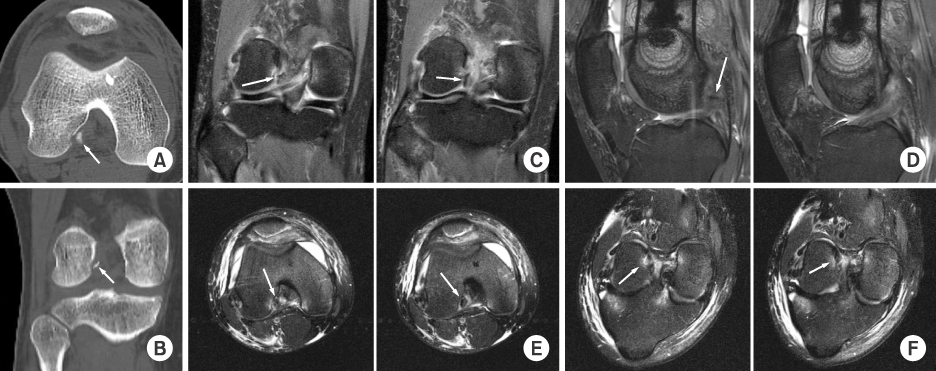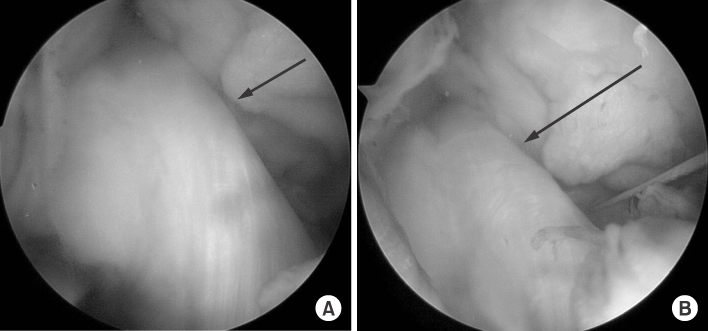J Korean Fract Soc.
2016 Jul;29(3):200-205. 10.12671/jkfs.2016.29.3.200.
Avulsion of the Femoral Attachment of Anterior Cruciate Ligament Associated with Ipsilateral Femoral Shaft Fracture in Skeletally Mature Patient: A Case Report
- Affiliations
-
- 1Department of Orthopaedic Surgery, CHA Bundang Medical Center, CHA University, Seongnam, Korea. wcchoios@chamc.co.kr
- KMID: 2344093
- DOI: http://doi.org/10.12671/jkfs.2016.29.3.200
Abstract
- Avulsion fracture at the femoral attachment of the anterior cruciate ligament (ACL) is very rare and has been reported mostly in skeletally immature patients. Authors experienced a case of avulsion fracture at the femoral attachment of ACL in a skeletally mature, a 21-year-old male associated with ipsilateral femoral shaft fracture. Here, authors report on the case with a literature review. Care should be taken because an avulsion fracture at the femoral attachment of ACL can be accompanied by ipsilateral femoral shaft fracture in skeletally mature patients.
Figure
Reference
-
1. Bengtson H, Giangarra C. Osteochondral avulsion fracture of the anterior cruciate ligament femoral origin in a 10-year-old child: a case report. J Athl Train. 2011; 46:451–455.
Article2. Kawate K, Fujisawa Y, Yajima H, Sugimoto K, Tomita Y, Takakura Y. Avulsion of the cartilaginous femoral origin of the anterior cruciate ligament in a three-year-old child. A case report with a thirteen-year follow-up. J Bone Joint Surg Am. 2004; 86:1787–1792.
Article3. Griffith JF, Antonio GE, Tong CW, Ming CK. Cruciate ligament avulsion fractures. Arthroscopy. 2004; 20:803–812.
Article4. Song EK, Seon JK, Park SJ, Yoon TR. Clinical outcome of avulsion fracture of the anterior cruciate ligament between children and adults. J Pediatr Orthop B. 2009; 18:335–338.
Article5. Nagarj R, Bali T, Kumar MN. Avulsion fracture of anterior cruciate ligament from femoral attachment in a skeletally mature patient: a case report. Southeast Asian J Case Rep Rev. 2015; 4:1595–1600.6. Matthews DE, Geissler WB. Arthroscopic suture fixation of displaced tibial eminence fractures. Arthroscopy. 1994; 10:418–423.
Article7. Caldas MTL, Malheiros DS, Lazzaroni AP, Avelino EA, Santos AJ. Injury of the knee ligaments associated with ipsilateral femoral shaft fractures. Rev Bras Ortop. 2013; 48:438–440.
Article8. van Raay JJ, Raaymakers EL, Dupree HW. Knee ligament injuries combined with ipsilateral tibial and femoral diaphyseal fractures: the "floating knee". Arch Orthop Trauma Surg. 1991; 110:75–77.
Article9. Trickey EL. Rupture of the posterior cruciate ligament of the knee. J Bone Joint Surg Br. 1968; 50:334–341.
Article10. Blacksin MF, Zurlo JV, Levy AS. Internal derangement of the knee after ipsilateral femoral shaft fracture: MR imaging findings. Skeletal Radiol. 1998; 27:434–439.
Article
- Full Text Links
- Actions
-
Cited
- CITED
-
- Close
- Share
- Similar articles
-
- Avulsion Fracture of Femoral Attachment of Anterior Cruciate Ligament in a 7-Year-Old Girl
- Knee Fractures and Ligament Injuries Associated with Ipsilateral Femoral Shaft Fractures: Mechanism of Injury, Site of th Knee Fracture and Ligament Injury
- Avulsion Fractures of the Anterior Cruciate and Posterior Cruciate Ligaments in a Skeletally Immature Child
- Avulsion Fracture of the Posterior Cruciate Ligament from Femoral Insertion Occurred in a Patient with Residual Poliomyelitis: A Case Report
- A Traumatic Anterior Hip Dislocation Associated Ipsilateral Femoral Shaft Segmental Fracture : Case Report






